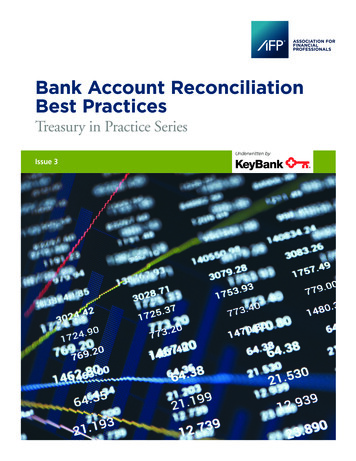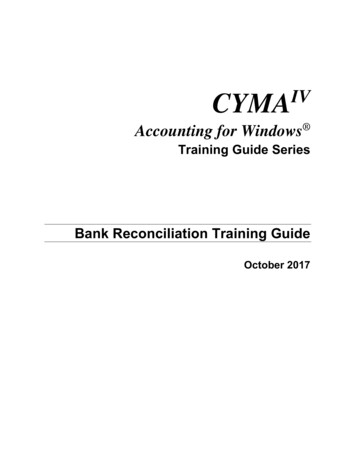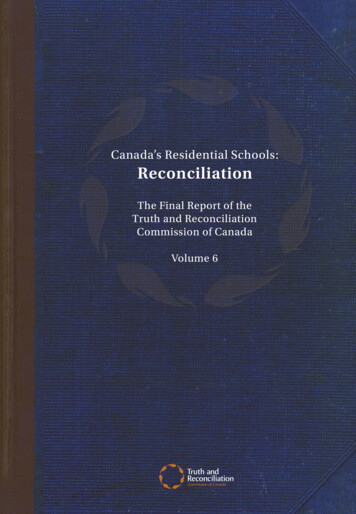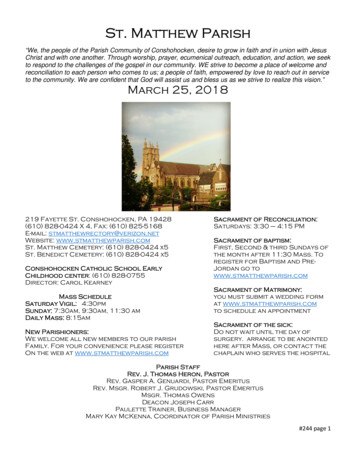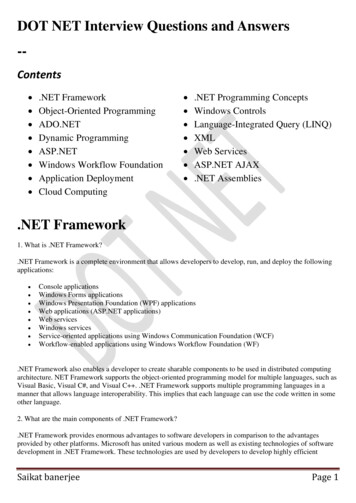
Transcription
American Journal of Business Education – December 2010Volume 3, Number 12A Conceptual Framework For The IndirectMethod Of Reporting Net Cash FlowFrom Operating ActivitiesTing J. (TJ) Wang, Governors State University, USAABSTRACTThis paper describes the fundamental concept of the reconciliation behind the indirect method ofthe statement of cash flows. A conceptual framework is presented to demonstrate how accrualand cash-basis accounting methods relate to each other and to illustrate the concept ofreconciling these two accounting methods. The conceptual framework recognizes additionalcategories of effects defined in the Accounting Standards Codification 230-10-45-28 andInternational Accounting Standards 7.18 (Statement of Financial Accounting Standards No. 95) inregard to the indirect method, which makes the concept of reconciliation between the accrual- andcash-basis more thorough and complete. The paper provides an approach to teaching the conceptof the reconciliation of accrual- and cash-based accounting methods.Keywords: Accrual; Deferral; Reconciliation; Cash flow; Indirect methodINTRODUCTIONIn college accounting programs, the statement of cash flows is usually scheduled for inclusion in theintermediate accounting courses even though the concept of cash flows; i.e., the direct method, may besuitable for business students in introductory financial accounting courses (O’Bryan, Berry, Troutman,and Quirin, 2000). The reason for this delay is that students must be acquainted with accrual-basis accounting inorder to understand the indirect method of statement of cash flows (i.e., the reconciliation between accrual- andcash-basis accounting methods). When learning the indirect method, students are shown how to add (subtract) noncash expenses and make changes in certain balance sheet accounts to (from) net income, and they are provided withrationale for some of the additions (subtractions) account-by-account in relation to the reconciliation of net incomeand net cash flow, as seen in many intermediate accounting textbooks (Kieso, Weygandt, and Warfield, 2010).However, students often simply memorize the formula for these additions and subtractions instead of learning andunderstanding the concept of the reconciliation (O’Bryan, Berry, Troutman, and Quirin, 2000).In the literature, in order to help students understand the indirect method, Rai (2003) shows how the changein cash account relates to changes in other accounts on the balance sheet using the basic accounting equation (or analgebraic approach) on financial statement data from two consecutive years. The changes in these balance sheetaccounts are then classified into operating, investing, and financing categories, according to the sections reported onthe statement of cash flows. This approach derives the additions and subtractions from the balance sheet accountsfor each of the three sections of the statement of cash flows. It shows the absolute relationship between net operatingcash flow and the additions to and subtractions from net income based on the derivations that arise from theaccounting equation.While Rai’s method provides an analytical approach to derive the absolute relationship of net operatingcash flow to the additions and subtractions of certain balance sheet accounts based on the accounting equation, hismethod does not provide the rationale for the additions and subtractions as related to the reconciliation of net incomeand net operating cash flow. That is, it does not explain the role of reconciliation; i.e., the fundamental relationshipbetween the accrual- and cash-basis accounting methods.19
American Journal of Business Education – December 2010Volume 3, Number 12Accounting textbooks provide some examples and rationale for the effects of the additions and subtractionson net income, but they give only fragments of the concept of the reconciliation; i.e., they analyze the effect of justone addition or subtraction at a time on net income or on operating cash flow. For example, an increase in accountsreceivable is one of the deductions because the increase (accrued revenues) was included in revenue (and netincome) but not in cash. As a result, an increase in accounts receivable is subtracted from net income in thereconciliation to derive net operating cash flow. However, many students have difficulty understanding the conceptand role of reconciliation. They have trouble understanding why any increase/decrease of balance sheet accountsshould be subtracted from/added to net income to begin with; i.e., the concept of reconciliation. Furthermore, manystudents have a hard time understanding the effect of changes in inventories on net income.Students’ difficulties in understanding the concept of reconciliation may be contributed by incompletedefinitions of the reconciliation/indirect method the standards and textbooks provide and by the fragmented singleaccount approach. For example, operating cash flows that do not affect income statement (i.e., cash transactionsdealing with current assets or liabilities) are not specified in the definitions of the reconciliation. Under GAAP, inAccounting Standards Codification (ASC) 230-10-45-28 (SFAS 95), it defines the reconciliation/indirect method asfollows: ―that which requires adjusting net income of a business entity or change in net assets of an NFP to removeboth of the following: 1) the effects of all deferrals of past operating cash receipts and payments, . , and allaccruals of expected future operating cash receipts and payments and 2) all items that are included in net incomethat do not affect net cash provided from .‖ In addition, under IFRS, in International Accounting Standards (IAS)7.18, it defines that ―the indirect method adjusts accrued basis net profit or loss for the effects of non-cashtransaction.‖ It is clear from these definitions that non-cash transactions, such as depreciation or amortizationexpense, be added back to net income since they had a negative effect (the higher the depreciation, the lower the netincome) on net income. Also, an increase in receivables reflects non-cash transaction or an item that is included inrevenues and net income but does not affect net cash. As a result, an increase in receivables will be subtracted fromnet income because it had a positive effect (the higher the increase, the higher the non-cash amount contained inrevenue, and the higher the non-cash amount in net income) on net income. However, the definitions do not mentionwhat happens to a decrease in receivables, a decrease in payables, or any operating items that are not included in theincome statement but do affect net cash (i.e., cash transaction that do not affect net income). Many students areconfused with changes in inventories with respect to the reconciliation because there are other accounts (i.e., cost ofgoods sold, purchases, beginning accounts payable, and ending accounts payable) involved at the same time. Thefragmented single-account approach is just not able to explain the effect of this change on net income at all.This paper will focus on the operating section of the statement of cash flows; i.e., the reconciliation/indirectmethod. As a result, we will use operating income instead of net income in the paper. The reconciliation processrequires two types of adjustments to the operating income: 1) to remove effects of accrual-basis operatingtransactions that have no effect on cash and 2) to include effects of cash-basis operating transactions that have noeffect on operating income. The adjustments from the former item are clearly identified in ASC 230-10-45-28, IAS7.18, and SFAS 95 par. 28, and covered in textbooks, but those from the latter are not specified (although shown inthe example), making the definition and explanations incomplete.To explain why and how the additions and subtractions relate to the reconciliation, one must first defineaccrual- and cash-basis accounting methods and demonstrate their relationship, then explain how the role ofreconciliation works based on their relationship, and finally show how the additions and subtractions can be derivedfollowing the reconciliation of accrual- and cash-basis accounting methods.To help students understand the reconciliation concept of the statement of cash flows, a conceptualframework is needed, which contains the basics of, and components in, both accrual- and cash-basis accounting;illustrates how the components of these two methods correspond to, and are reconciled with, each other; and showsthe role of adjustments in the reconciliation.This paper creates a conceptual framework to present the fundamental logic behind the indirect method forreconciling operating income to net operating cash flow. Further, the paper applies accounting terms related to ASC23-10-45-28, lays out the components from both accrual- and cash-basis accounting, demonstrates the relationshipsamong the components, derives the additions and subtractions, provides the rationale for the reconciliation in theindirect method, and describes the application of the framework.20
American Journal of Business Education – December 2010Volume 3, Number 12A CONCEPTUAL FRAMEWORKTerms and Their RelationshipsBefore the conceptual framework can be presented, students must have a simple and basic understanding ofa number of accounting terms, such as accrual, deferral, recognition and realization, their implications, and types oftransactions (i.e., operating, financing and investing). Definitions and examples of these terms can be found in manyfinancial accounting textbooks. For example, in accrual-basis accounting: revenues are recognized when they areearned, and expenses are recognized when they are incurred; revenues recognized before cash flow (or accruedrevenues) will cause receivables to increase; and cash flow realized after being recognized will cause receivables todecrease.To understand the conceptual framework for the indirect method of the statement of cash flows, the firststep is to look at the operating transactions based on the sequence of occurrence between performance recognitions(i.e., revenues and expenses) and cash flow realizations (i.e., cash receipts and payments). We will focus on theindirect method of the statement of cash flows and target only the operating transactions. As a result, we willexclude financing and investing transactions from the conceptual framework in the paper. That is, we will useoperating income instead of net income in the framework.In general, all operating transactions involve exchanges of resources between the firm and other parties,internal or external—any exchanges that may or may not be completed by the end of a given reporting period. Forexample, a firm may deliver a part of or all goods and/or provide services to other parties prior to, at the time of,and/or after the receipts of cash payment. On the other hand, a firm may utilize resources and/or receive servicesprovided by other parties prior to, at the time of, and/or after the payments of cash.However, while only two transaction patterns have been defined by ASC 230-10-45-28 (SFAS 95) andincluded in accounting textbooks, we have identified six different transaction patterns in the conceptual framework.The six patterns are categorized based on the ―sequence‖ of and ―timing‖ of occurrence of a firm’s performance andits related cash flows. There are two possible ―sequences‖ of the firm’s performance (i.e., recognitions of revenuesor expenses) and its related cash flows; i.e., (1) performance occurs prior to cash flows and (2) cash flows occurprior to performance, and three possible ―timings‖ of these occurrences; i.e., (1) current-future, (2) past-current and(3) current-current accounting periods. The six patterns (i.e., 2 x 3) are as follows: Pattern 1, when the firm deliversgoods or provides services to (utilizes resources or receives services provided by) other parties during the currentaccounting period prior to the receipts (payments) of cash in the future accounting periods [Performance CashFlows & Current-Future]; Pattern 2, when the firm receives cash from (pays cash to) other parties during the currentaccounting period for the goods delivered or services provided (resources utilized or services received) from pastaccounting periods [Performance Cash Flows & Past-Current]; Pattern 3, when the firm delivers goods or providesservices to (utilizes resources or receives services provided by) other parties during the current accounting periodbut receives (makes) the payments of cash either at the time of delivery or by the end of the same current accountingperiod [Performance Cash Flows & Current-Current]; Pattern 4, when the firm receives cash from (pays cash to)other parties during the current accounting period for goods or services (resources or services) to be delivered (used)in the future accounting periods [Cash Flows Performance & Current-Future]; Pattern 5, when the firm deliversgoods or provides services to (utilizes resources or services provided by) other parties during the current accountingperiod after receiving (making) the payments of cash from past accounting periods [Cash Flows Performance &Past-Current]; and Pattern 6, when the firm receives payments of cash from (pays to) other parties during the currentaccounting period but delivers goods or provides services (utilizes resources or receives services) either at the timeof the payment or by the end of the same accounting period [Cash Flows Performance & Current-Current]. Atransaction may follow one or a combination of these six transaction patterns.Figure 1 illustrates these six transaction patterns and their terms which were created by the author using thesame naming approach as in ASC 230-10-45-28 (SFAS 95).21
American Journal of Business Education – December 2010Figure 1: Patterns of the Operating TransactionsPatternVolume 3, Number 12Terms 1 23 LEGENDThe firm delivers goods orprovides services to(utilizes resources orreceives services providedby) other partiesCash flows of past accrualsAccruals of current cash flows and 4Accruals of expected future cash flows(as defined in ASC 230-10-45-28)Cash flows of future deferralsThe firm receivespayments of cash from(pays cash to) other parties tCurrent accounting periodt – i Past accounting periods5Deferrals of past cash flows (asdefined in ASC 230-10-45-28) t i Future accounting periodsi 1, 2, 3, . . . , n6andCash flows of current deferrals Time (Accounting Period)t-i(Past)t(Current)t i(Future)22
American Journal of Business Education – December 2010Volume 3, Number 12In ASC 230-10-45-28, the term ―accruals of expected future operating cash receipts and payments‖ isconsistent with transactions in Pattern 1 when the firm delivers goods or provides services to (utilizes resources orreceives services provided by) other parties during the current accounting period prior to the receipts (payments) ofcash in the future accounting periods. These transactions are accrued revenues and accrued expenses, for which wedebit Receivables and credit Revenues for the accrued revenues, and debit Expenses and credit Payables for theaccrued expenses in the recording of the transactions.Another term defined in ASC 230-10-45-28 is ―deferrals of past operating cash receipts and payments,‖which is consistent with transactions in Pattern 5, when the firm delivers goods or provides services to (utilizesresources or services provided by) other parties during the current accounting period after receiving (making) thepayments of cash from past accounting periods. These transactions include debiting Deferred Liabilities (e.g.,Unearned Revenues) and crediting Revenues, as well as debiting Expenses and crediting Deferred Assets (e.g.,Prepayments).As seen in ASC 230-10-45-28, there are two elements in the naming of terms; for example,accruals/deferrals (i.e., the sequence of the recognition of performance and the realization of its related cash flows),and past/expected future (i.e., the timing of operating cash receipts and payments). From here on, we will use thegeneral term ―cash flows‖ to mean ―operating cash receipts and payments‖ since we limit the scope of theframework to the operating transactions only. ASC 230-10-45-28 uses ―accruals‖ for the recognitions ofperformance that occur before realization of the related cash flow, and it uses ―deferrals‖ for the recognitions ofperformance that occur after realization of the cash flow. The current accounting period is referred in this paper asthe time period which the most current financial statements; i.e., the period in which the recognitions of revenuesand expenses took place, cover. We use the same naming convention as in ASC 230-10-45-28 with the elementsinvolved in the six patterns to create terms such as ―cash flows of past accruals‖, ―accruals of current cash flows‖,―cash flows of future deferrals‖, and ―cash flows of current deferrals‖ for Patterns 2, 3, 4, and 6, respectively.Operating transactions in ―cash flows of past accruals‖ (Pattern 2) are follow-up related transactions from ―accrualsof expected future cash flows‖ (Pattern 1), and transactions in ―deferrals of past cash flows‖ (Pattern 5) are followup related transactions from ―cash flows of future deferrals‖ (or Pattern 4). Although net effects on the accountsfrom transactions in ―accruals of current cash flows‖ (Pattern 3) and ―cash flows of current deferrals‖ (Pattern 6) arethe same at the end of current accounting period, the actual sequence of occurrence in the transactions might bedifferent. As mentioned before, an actual transaction may consist of multiple patterns of transactions classifiedabove.Accrual- Versus Cash-Basis Accounting MethodsAfter the terms of the components of both accounting methods are understood as delineated above, the nextstep is to examine the operating transactions, both accrual- and cash-basis, that have been recorded by the end of thecurrent period, including all year-end adjustments, as depicted in Figure 2. Giving six patterns of operatingtransactions, there are four of them that would affect operating income and four of them net operating cash flow.The patterns of transactions that would affect operating income are ―accruals of expected future cash flows‖ (Pattern1), ―accruals of current cash flows‖ (Pattern 3), ―deferrals of past cash flows‖ (Pattern 5), and ―cash flows of currentdeferrals‖ (Pattern 6) because the firm has performed (i.e., delivered goods and/or provided services or utilizedresources and/or received goods/services) during the current accounting period. On the other hand, the patterns oftransactions that would affect net operating cash flow include ―cash flows of past accruals‖ (Pattern 2), ―accruals ofcurrent cash flows‖ (Pattern 3), ―cash flows of future deferrals‖ (Pattern 4), and ―cash flows of current deferrals‖(Pattern 6) because the firm has received/used cash during the current accounting period.Transactions in ―accruals of current cash flows‖ (Pattern 3) and ―cash flows of current deferrals‖ (Pattern6) are included under both accrual- and cash-basis accounting methods because, in these transactions, recognitions(revenues and expenses affecting operating net income) and realizations (cash receipts and payments affecting netoperating cash) have occurred at the same time or at different times by the end of the current accounting period.23
American Journal of Business Education – December 2010Volume 3, Number 12Figure 2: Reconciliation of Accrual- and Cash-basis AccountingPatternPatternAccrual-Basis 13and3and t 46t-iand 5 2 Cash-Basisand6t it-i Operating Income tt i Net Operating Cash FlowReconciliationRemove the effects of Patterns 1 and 5 and includeeffects of Patterns 2 and 4 to obtain the NetOperating Cash FlowRemove the effects of Patterns 2 and 4 and includeeffects of Patterns 1 and 5 to obtain the OperatingIncome24
American Journal of Business Education – December 2010Volume 3, Number 12Another way of looking at these two accounting bases is to note that operating transactions which areassociated with performance in the current period under the ―accrual-basis‖ are all reflected in the operating incomein the current accounting period with their associated cash flows occurring in the past, current or future accountingperiods. On the other hand, operating transactions which are associated with cash flows in the current period underthe ―cash-basis‖ are all accounted in the net operating cash flow with their related performance recognized in thepast, current or future accounting periods (i.e., recognitions that occurred in the past, are occurring in the current, orare expected to occur in the future accounting periods). Operating transactions in Patterns 3 and 6 are all reflected inthe operating income and net operating cash flow in the current accounting period. As a result, these transactionpatterns affect both ―accrual-basis‖ and ―cash-basis‖ accounting concurrently, making them irrelevant in thereconciliation of these two methods.On the other hand, operating transactions in Patterns 1 and 5 are reflected in the operating income but notin the net operating cash flow because their related cash flows are expected to be realized in the future (Pattern 1) orhave been realized in the past (Pattern 5) periods. Operating transactions in Patterns 2 and 4 are reflected in the netoperating cash flow but not in the operating income because their related recognitions of revenues and expenseshave been occurred in the past (Pattern 2) or are expected to be occurred in the future (Pattern 4) periods.The Concept of ReconciliationAll operating transactions under ―accrual-basis‖--some of which are related to revenues and others toexpenses--are included in the calculations of the current income statement. Thus, the end result under the ―accrualbasis‖ method is the operating income reported (i.e., revenues – expenses) on the income statement, which disclosesthe performance outcome of the current accounting period.The end result from operating transactions under the ―cash-basis‖ is the change in cash/net operating cashflow (i.e., cash inflows – cash outflows) from that period, which is disclosed on the statement of cash flows.Therefore, to reconcile operating income (accrual-basis) to net operating cash flow (cash-basis) is to show how toobtain the result of ―cash-basis‖ transactions from the result of ―accrual-basis‖ transactions using the similarity anddifferences of the types of transactions (i.e., components) identified under both ―accrual-basis‖ and ―cash-basis‖accounting methods.To carry out this reconciliation, we simply exclude types of transactions (i.e., components) that are under―accrual-basis‖ but not under ―cash-basis‖ and then include types of transactions that are under ―cash-basis‖ but notunder ―accrual-basis‖. That is, we exclude ―accruals of expected future cash flows‖ (Pattern 1) and ―deferrals of pastcash flows‖ (Pattern 5) from ―accrual-basis‖ transactions (or from the end result--operating income), and theninclude ―cash flows of past accruals‖ (Pattern 2) and ―cash flows of future deferrals‖ (Pattern 4) to obtain the resultof ―cash-basis‖ transactions; i.e., net operating cash flow.In other words, operating transactions in Patterns 1 and 5 affected operating income but did not affect cash,and operating transactions in Patterns 2 and 4 affected cash but did not affect operating income. Thus, to reconcileoperating income to net operating cash flow is to remove effects of transactions found in Patterns 1 and 5 onoperating income and include effects of transactions found in Patterns 2 and 4 to obtain net operating cash flow.VALIDATION OF THE FRAMEWORKIn this section, we will demonstrate how the logic of the reconciliation outlined above can actually beapplied by excluding the effects of transactions in Patterns 1 and 5 from operating income and including the effectsof transactions in Patterns 2 and 4 to operating income using major and commonly observed categories from theincome statement, such as revenues, cost of goods sold, depreciation, and other expenses. In other words, we willillustrate how to obtain the additions and subtractions seen in the textbooks directly from the conceptual frameworkoutlined above.25
American Journal of Business Education – December 2010Volume 3, Number 12Figure 3: Effects of Accrual- and Cash-basis Accounting on Balance Sheet AccountsIncome StatementAccrual-BasedBalance Sheet AccountsPattern and 13 5 Revenues Receivables Expenses PayablesStatement of Cash FlowCash-BasedPattern 2 Receivables Cash Payables Cash Revenues Cash Expenses Cash Revenues Deferred Liab. Expenses Deferred Assets3 4 Deferred Liab. Cash Deferred Assets Cashand 6 Revenues Cash Expenses Cash6and t-i and tt it-i26tt i
American Journal of Business Education – December 2010Column AIncome StatementItemsTable I: Rationales of the Additions and Subtractions of Balance Sheet Accounts in the ReconciliationAccrual-Basis (To be Excluded)Cash-Basis (To be Included)Column FColumn BColumn EColumn CColumn DAdjustments to Net Income due toPattern 1: Accruals ofPattern 4: CF of FuturePattern 5: Deferrals of PastPattern 2: CF of PastColumns B EExp. Future CFDeferralsCFAccrualsRevenuesCredit sales includedand A/R increased.( A/R)- COGSCredit purchasesincluded and A/Pincreased.( A/P)Advanced sales recognizedand Unearned Revenuedecreased.( Unearned Revenue)Sales collection receivedand A/R decreased.( A/R)Advanced sales includedand Unearned Revenueincreased.( Unearned Revenue)Credit purchases paid andA/P decreased.( A/P)Expenses accrued andPayables increased.( Payables)Prepaid expenses recognizedand Prepayment decreased.( Prepayments)- Δ A/R Δ Unearned Revenue Δ A/P- Δ InventoriesDepreciation allocated andDepreciation Expenseincreased.( Depreciation Exp)- Depreciation- ExpensesVolume 3, Number 12 DepreciationPayment of accruedexpenses and Payablesdecreased.( Payables)Prepaid expenses andPrepayment increased.( Prepayments) Δ Payables- Δ Prepayments Net IncomeCOGS Cost of Goods Sold, (i.e., Beginning Inventories Net Purchases – Ending Inventories); Exp Expected; CF Cash Flows; A/R Accounts Receivable; A/P AccountsPayable.Result:Net Operating CF Net Income excludes effects from Columns B and C and includes effects from Columns D and E Net Income – Δ A/R Δ Unearned Revenue Δ A/P – Δ Inventories Depreciation Δ Payables – Δ Prepayments27
American Journal of Business Education – December 2010Volume 3, Number 12Operating transactions in Patterns 1 and 5 have already been accounted in operating income for the currentperiod. These two patterns of transactions might cause operating income to increase or decrease depending on thetypes of transactions. For example, recognized revenues (revenues were credited) from Patterns 1 and 5 would causeoperating income to increase while recognized expenses (expenses were debited) would cause operating income todecrease. To exclude Patterns 1 and 5 is equivalent to removing their effects (i.e., increases or decreases) from theend result of operating income, which is also consistent with the language used in the ASC 230-10-45-28. Thus, wewill add their effects back to operating income if they were subtracted to derive operating income (i.e., causedoperating income to decrease--recognized expenses), and subtract the effects from operating income if they wereadded to derive operating income (i.e., caused operating income to increase--recognized revenues).When transactions in Patterns 1 and 5 have effects on operating income, they must have effects on thebalance sheet accounts as seen in Figure 3, according to the double-entry bookkeeping system. For example,operating transactions in Pattern 1; i.e., accrued revenues (expenses) have increased (decreased) operating income,so they must have also increased receivables (payables). Transactions in Pattern 5; i.e., deferrals of past cash flows(receipts and payments), have increased (decreased) operating income, so they must have also decreased deferredliabilities (assets). Furthermore, when transactions in Patterns 2 and 4 have effects on cash, they must have effectson the balance sheet accounts. For example, transactions in Pattern 2; i.e., cash flows of past accruals, haveincreased (decreased) cash, so they must have also decreased receivables (payables). Transactions in Pattern 4; i.e.,cash flows of future deferrals, have increased (decreased) cash, so they must have also increased deferred liabilities(assets). As a result, these increases and decreases (changes) in balance sheet accounts can be used to reflect (i.e.,proxy for) the effects on operating income and cash from transactions addressed above and used in the adjustmentsin the reconciliation of the two accounting bases.To demonstrate how the additions and subtractions can actually be derived from the conceptual framework,let's first decompose the major income statement categories into types of transactions according to the following:Pattern 1, ―accruals of expected future cash flow‖; Pattern 2, ―cash flows of past accruals‖; Pattern 4, ―cash flows offuture deferrals‖; and Pattern 5, ―deferrals of past cash flows‖.Next, we shall identify the effects of these patterns on operating income and net operating cash flow and,subsequently, make appropriate adjustments in order to remove or include their effects. In Table I, the major incomestatement categories are listed in Column A. ―Accruals of expected future cash flows‖ are shown in Column B(Pattern 1). Column C shows ―deferrals of past cash flows‖ (Pattern 5). Columns D and E list ―cash flows of pastaccruals‖ (Pattern 2) and ―cash flows of future deferrals‖ (Pattern 4), respectively. Column F reports the adjustmentsthat will be needed to remove and include the effects that Columns B to E have had on operating income. Thesea
cash flow to the additions and subtractions of certain balance sheet accounts based on the accounting equation, his method does not provide the rationale for the additions and subtractions as related to the reconciliation of net income and net operating cash flow. That is, it does not explain the role of reconciliation; i.e., the fundamental .


